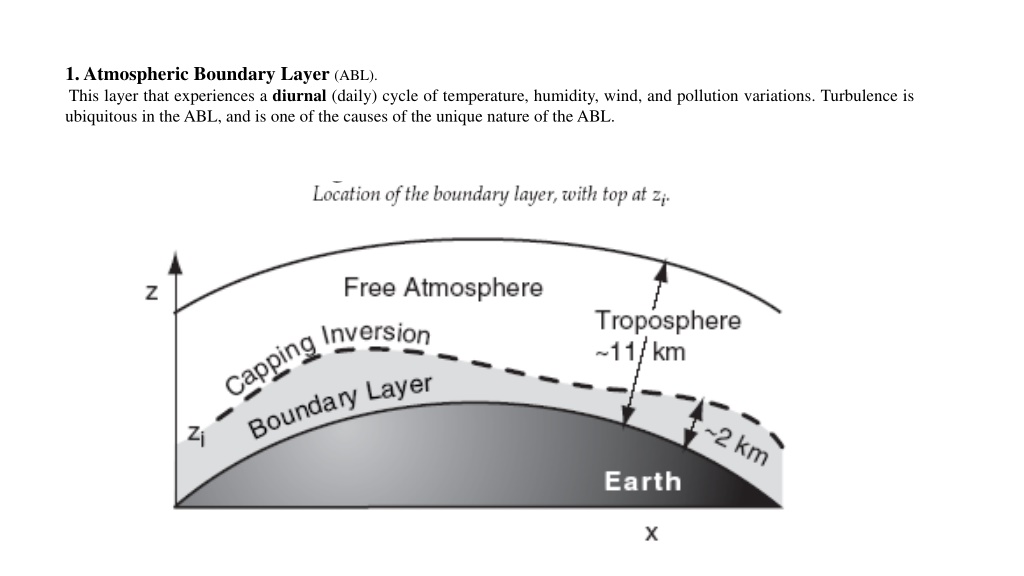Understanding Atmospheric Boundary Layer and Static Stability
The Atmospheric Boundary Layer (ABL) undergoes daily variations in temperature, humidity, wind, and pollution with turbulence being a key factor. Static stability in the environment determines the behavior of air parcels, leading to categorizations of stable, unstable, and neutral conditions based on buoyancy forces. The concept of potential temperature for dry air parcels is also discussed in relation to adiabatic processes.
Download Presentation

Please find below an Image/Link to download the presentation.
The content on the website is provided AS IS for your information and personal use only. It may not be sold, licensed, or shared on other websites without obtaining consent from the author. Download presentation by click this link. If you encounter any issues during the download, it is possible that the publisher has removed the file from their server.
E N D
Presentation Transcript
1. Atmospheric Boundary Layer (ABL). This layer that experiences a diurnal (daily) cycle of temperature, humidity, wind, and pollution variations. Turbulence is ubiquitous in the ABL, and is one of the causes of the unique nature of the ABL.
2. Static Stability : Figure 2, Let the standard atmosphere represent the environment or the background air. Consider an air parcel captured from one part of that environment (plotted as the circle). At its initial height, the parcel has the same temperature as the surrounding environment, and experiences no buoyant forces. To determine static stability, you must ask what would happen to the air parcel if it were forcibly displaced a small distance up or down. When moved from its initial capture altitude, the parcel temperatures could differ, thereby causing buoyant forces. and environment
If the buoyant forces on a displaced air parcel push it back to its starting altitude, then the environment is said to be Statically Stable. In the absence of any other forces, statically stable air is laminar. Namely, it is smooth and non-turbulent. if the displaced parcel is pulled further away from its starting point by buoyancy, the portion of the atmosphere through which the air parcel continues accelerating is classified as staticallyunstable. Unstable regions are turbulent (gusty). If the displaced air parcel has a temperature equal to that of its new surroundings, then the environment is statically neutral.
If an air parcel is captured at P = 83 kPa and T = 5C (as sketched in Fig., and is then is forcibly lifted dry adiabatically, it cools following the = 20 C adiabatic (one of the thin diagonal lines in that figure). If lifted to a height where the pressure is P = 60 kPa, its new temperature is about T = 20 C. This air parcel, being colder than the environment (thick dotted line in Fig.) and feels a downward buoyant force toward its starting point. Similarly if displaced downward from its initial height, the parcel is warmer than its surroundings at its new height, and would feel an upward force toward its starting point.
potential temperature The temperature that an unsaturated parcel of dry air would have if brought adiabatically and reversibly from its initial state to a standard pressure, p0, typically 100 kPa. Its mathematical expression is: = where is the potential temperature, T is temperature, and is the Poisson constant. This exponent is often assumed to be 2/7, the ratio of the gas constant to the specific heat capacity at constant pressure for an ideal diatomic gas. See virtual potential temperature, liquid water potential temperature, equivalent potential temperature, wet-bulb potential temperature.
3. Boundary-Layer Formation 3.1 Tropospheric Constraints standard atmosphere is replotted as the thick dotted grey line in Fig 3., but now in terms of its potential temperature ( ) versus height (z). The standard atmosphere slopes toward warmer potential temperatures at greater altitudes. Such a slope indicates statically stable air; namely, air that opposes vertical motion. The ABL is often turbulent. Because turbulence causes mixing, the bottom part of the standard atmosphere becomes homogenized. Namely, within the turbulent region, warmer potential-temperature air from the standard atmosphere in the top of the ABL is mixed with cooler potential-temperature air from near the bottom. The resulting mixture has a medium potential temperature that is uniform with height, as plotted by the thick black line in Fig.3. In situations of vigorous turbulence, the ABL is also called the mixed layer (ML).
Example: Find the vertical gradient of potential temperature in the troposphere for a standard atmosphere. Solution Known T/ z = 6.5 C/km ( average moist adiabatic lapse rate), Find: / z = ? C/km from known relationship between T and equation : (z) = T(z) + d z , where the dry adiabatic lapse rate is d = 9.8 C/km Apply this at heights z1 and z2, and then subtract the z1 equation from the z2 equation: ( 2 1 ) = (T2 T1 ) + d (z2 z1) Divide both sides of the equation by (z2 z1). Then define (z2 z1) = z , (T2 T1) = T , and ( 2 1) = to give the algebraic form of the answer: ( / z ) = ( T/ z) + d This eq. applies to any vertical temperature profile. If we plug in the temperature profile for the standard atmosphere: / z = ( 6.5 C/km) + (9.8 C/km) = 3.3 C/km Check: Units OK. Agrees with Fig 3. , where increases from 15 C at the surface to 51.3 C at 11 km altitude, which gives (51.3 15 C)/(11km) = 3.3 C/km. Discussion: gradually increases with height in the troposphere, which as we will see tends to gently oppose vertical motions. Although the standard-atmosphere in troposphere is statically stable, the real troposphere at any time and place can have layers that are statically stable, neutral, or unstable.
Above the mixed layer, the air is usually unmodified by turbulence, and retains the same temperature profile as the standard atmosphere in this idealized scenario. This tropospheric air above the ABL is known as the free atmosphere (FA). As a result of a turbulent mixed layer being adjacent to the unmixed free atmosphere, there is a sharp temperature increase at the mixed layer top. This transition zone is very stable, and is often a temperature inversion. Namely, it is a region where temperature increases with height. The altitude of the middle of this inversion is given the symbol zi, and is a measure of the depth of the turbulent ABL.
There is always a strong stable layer or temperature inversion capping the ABL. As we have seen, turbulent mixing in the bottom of the statically-stable troposphere creates this cap, and in turn this cap traps turbulence below it. The capping inversion troposphere into two parts. Vigorous turbulence within the ABL causes the ABL to respond quickly to surface influences such as heating and frictional drag. However, the remainder of the troposphere does not experience this strong turbulent coupling with the surface, and hence does not experience frictional drag nor a daily heating cycle. Fig. 4 illustrates this. breaks the
3.2 Synoptic Forcings Weather patterns such as high (H) and low (L) pressure systems that are drawn on weather maps The outward spiral of winds around highs is called divergence, and removes ABL air horizontally from the center of highs. Conservation of air mass requires subsidence (downward moving air) over highs to replace the horizontally diverging air Fig. Although this subsidence pushes free atmosphere air downward, it cannot penetrate into the ABL because of the strong capping inversion. Instead, the capping inversion is pushed downward closer to the ground as the ABL becomes thinner. This situation traps air pollutants in a shallow ABL, causing air stagnation and air-pollution episodes.
At a frontal zone, the colder, heavier airmass acts like a wedge under the warm airmass. As winds blow the cold and warm air masses toward each other, the cold wedge causes the warm ABL to peel away from the ground, causing it to ride up over the colder air (Figs. 6a). Also, thunderstorms can vent ABL air away from the ground (Figs. 6a & b). It is mainly in these stormy conditions (statically stable conditions at fronts, and statically unstable conditions at thunderstorms) that ABL air is forced away from the surface. Although an ABL forms in the advancing airmass behind the front, the warm humid air that was pushed aloft is not called an ABL because it has lost contact with the surface. Instead, this rising warm air cools, allowing water vapor to condense and make the clouds that we often associate with fronts. For synoptic-scale low-pressure systems, it is difficult to define a separate ABL, so boundary-layer meteorologists study the air below cloud base.
4. ABL Structure and Evolution The fair-weather ABL consists of the components sketched in Fig.7. During daytime there is a statically- unstable mixed layer (ML). At night, a statically stable boundary layer (SBL) forms under a statically neutral residual layer (RL). The residual layer contains the pollutants and moisture from the previous mixed layer, but is not very turbulent. The bottom 20 to 200 m of the ABL is called the surface layer ( SL, Fig.8 ). Here frictional drag, heat conduction, and evaporation from the surface cause substantial variations of wind speed, temperature, and humidity with height.
However, turbulent fluxes are relatively uniform with height; hence, the surface layer is known as the constant flux layer. Separating the free atmosphere (FA) from the mixed layer is a strongly stable entrainment zone (EZ) of intermittent turbulence. Mixed-layer depth zi is the distance between the ground and the middle of the EZ. At night, turbulence in the EZ ceases, leaving a non-turbulent layer called the capping inversion (CI) that is still strongly statically stable. Typical vertical profiles of temperature, potential temperature, humidity mixing ratio, and wind speed are sketched in Fig. 18.9. The day portion of Fig. 8 corresponds to the 3 PM time indicated in Fig 8, while night is for 3 AM. Next, look at ABL temperature, winds, and turbulence in more detail.























